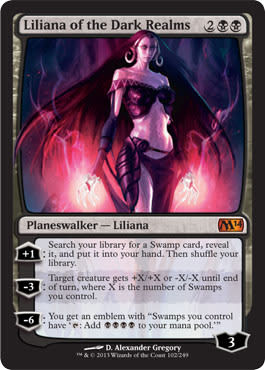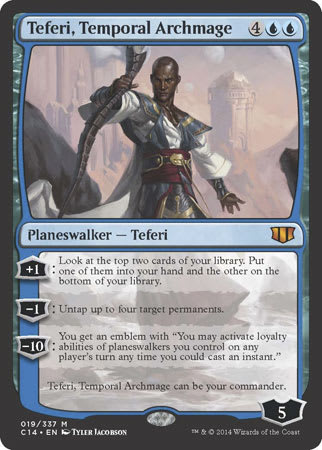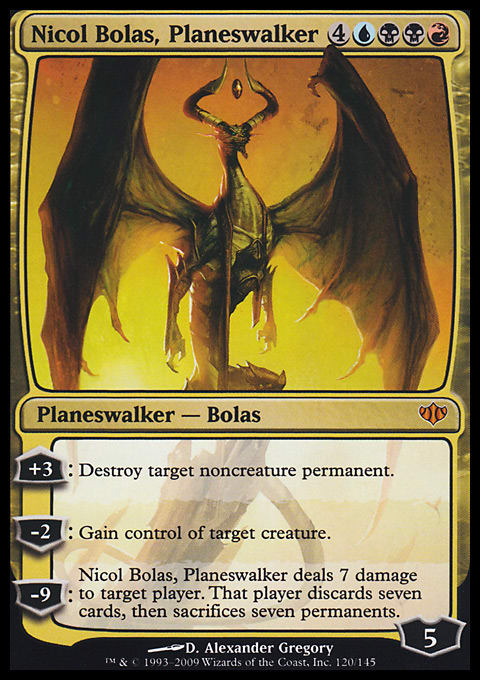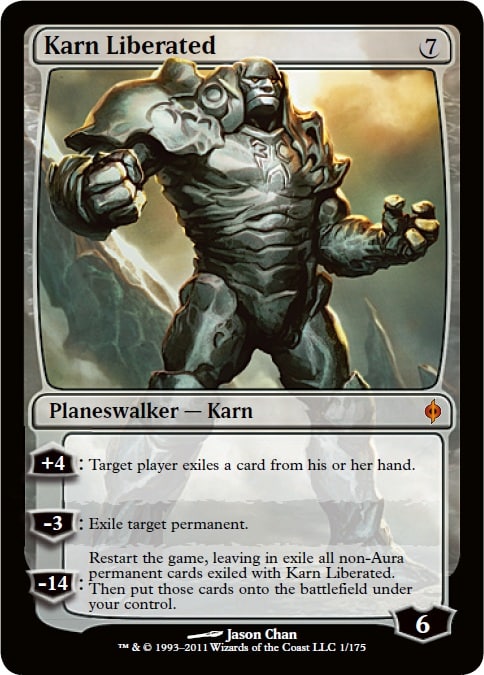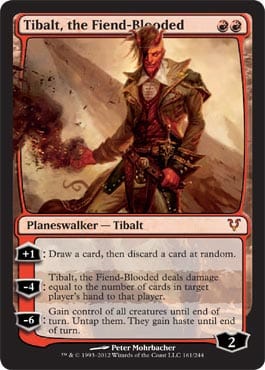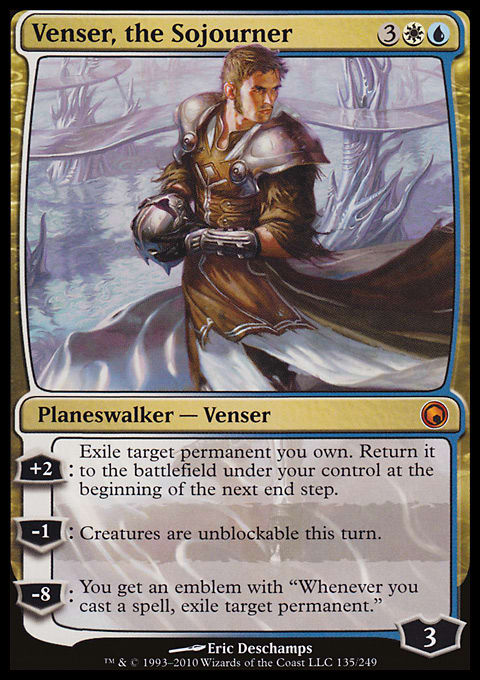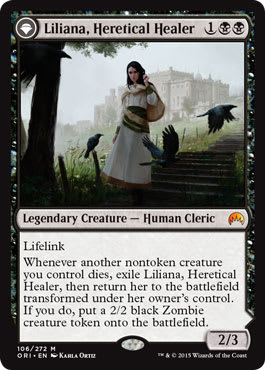A long time ago, I argued that the best way to use Planeswalkers was to focus on milking as much value as you can from their minor abilities rather than trying to get a ticket to Magical Christmas Land and expecting to use their ultimates regularly. That is still a pretty good rule, but there are some exceptions when you can play things a little differently. I was talking to Bruce Richard about Liliana, Defiant Necromancer recently (you can read his article here—brutal mono-black Commander list included!) as well as playing against my buddy Earl’s ridonkulous Liliana deck, and that got me thinking about when it’s time to change the rules.
Tactical Planeswalkers
Let’s start by looking at three of my favorite Planeswalkers for multiplayer: Nicol Bolas, Planeswalker, Sorin Markov, and Liliana of the Dark Realms. These exemplify the typical way that Planeswalkers are used. I usually steal a creature with Nicol Bolas, blast an opponent down to 10 life with Sorin, or fetch a Swamp with Lili. After that, I plus them when I can and minus them when I must, trying to keep ahead of the damage they’ve taken for as long as possible. My main goal is to milk them for as much value as I can, both because I so rarely go ultimate with them because, as their loyalty increases, they come under more pressure, so I need to sink more resources into defending them.
At their passing, my grief is assuaged by the fact that they sacrificed themselves to prevent damage to me, and I have to respect their sacrifice. I carry on with the game—because that’s what Sorin would've wanted.
This is how most Planeswalkers are used most of the time, and this can be considered tactical use of Planeswalkers. From turn to turn, you decide what is the best ability to use and how many resources to use to defend them. Sure, you might be willing to empty your hand or let your whole team die chump-blocking to defend Lili 3 with 6 loyalty, but what about 5 loyalty? 4? The answer is usually, “No,” because those are resources that you need to win the game, and the Planeswalker is usually just one weapon in your arsenal, not worth giving up all your other weapons for. Even the fearsome and spendy Jace, the Mind Sculptor has an ultimate that will, at best, kill a single opponent, and cards like Liliana Vess and Garruk, Primal Hunter leave you painfully vulnerable to a sweeper. In other words, winning the game is more important than getting a Planeswalker’s ultimate to go off—the ultimate usually isn't enough to win it for you, and spending the resources you lose protecting them make it harder to actually win the game.
Strategic Planeswalkers
However, there are some cases when your Planeswalker’s ultimate is the Holy Grail: if you get it off, you're going to win, and then everything else becomes secondary to reaching that goal. This might be a game-time decision: You realize that the stars have aligned to give you a chance that you wouldn’t usually get, or it might even be the entire focus of the deck (we writers call that foreshadowing). Whichever the case, there are some games in which you’re actually playing a subgame with your Planeswalker; instead of playing Win the Game, you’re playing Go Ultimate with Teferi, knowing that if you win that subgame, you’ll win the whole thing. In this case, you go from using Planeswalkers tactically to playing them strategically.
The thing about a subgame is that the rest of the table might not even know that the rules for winning the game have changed; if you're the only one who knows what the game really is, you have a huge advantage, but it can be hard to recognize the opportunity when it comes along, and that window can close quickly. There are two things you need to look for: Can you get it off, and will it be enough to put the game away? The first is tough, and the second is very rare indeed.
Sometimes, you can go ultimate by laying low or getting your opponents to underestimate your board position. Maybe everyone ignored your Planeswalker while dealing with another threat, and they just don’t know that you’re ready to go off (my buddy Earl says, “A noticed play is a blown play,” and he gets off ultimates while the rest of the table is giving my Planeswalkers the bum’s rush, so he must be doing something right). Maybe they assume that someone else will deal with it, but nobody realizes you have all the tools you need to protect your Planeswalker. Maybe you're about to go to town with a Contagion Engine and push your Planeswalker up to the ultimate threshold in a single turn.
The previous three examples are all pretty easy to figure out, and if you care enough to be reading strategy articles online, you would probably be able to recognize The Opportune Moment and seize it. But sometimes, you have to set those situations up in advance. Sometimes, you’ll need to sacrifice a really good creature to prevent damage to a Planeswalker who is only halfway ready. Sometimes, you’ll need to hold back on playing the card until the board is a little less crowded or use up all of your resources over a couple of turns to buy time for a Planeswalker to do its job (this is called the Serenity ManeuverTM). You might even need to use a sweeper to take out a single creature if that creature is a threat to your Planeswalker.
In these kinds of situations, the factors you need to consider are pretty straightforward: How hard can your opponents come at your Planeswalker, and what do you have to protect them? But the other thing to consider is, Will it be enough to win? If not, you're throwing away resources in pursuit of a sideshow. The thing about Planeswalkers is that winning with them requires more than just the ultimate; you also need the right kind of support for them. To show you what I mean, here is my list of the top ten best strategic Planeswalkers, cards that are most likely to win the game for you if you get their ultimates off. Like most lists you’ll find here on Gathering Magic, the ordering is objectively determined based on a complex algorithm combining all conceivable factors and is therefore indisputable fact.
- Sorin, Solemn Visitor
- Narset Transcendent
- Koth of the Hammer
- Domri Rade
- Tibalt, the Fiend-Blooded
- Teferi, Temporal Archmage
- Venser, the Sojourner
- Liliana, Defiant Necromancer
- Tamiyo, the Moon Sage
- Karn Liberated
Notice anything interesting? Every one of them needs something else to seal the deal; getting their ultimates off gives you a greatly increased chance of winning, but it isn't sufficient.
Sorin, Solemn Visitor — Will this Sheoldred, Whispering One effect be enough to control your opponents, or are you dealing with tokens and weenies? Do you have something to push through damage while your opponents are defenseless?
Narset Transcendent — Are your opponents relying on noncreature spells, or can they handle this? Do they already have enough of a board presence to finish you off before you can take advantage of this effect?
Koth of the Hammer — Do you have enough Mountains to get the job done, or are you up against a Trostani, Selesnya's Voice deck with a Serra Avatar?
Domri Rade — Show me the doodz!!!
Tibalt, the Fiend-Blooded — Show me the doodz! With Insurrection, you can choose The Opportune Moment to cast it, but with Tibalt, you have less choice of timing, and your opponents are more likely to play around him.
Teferi, Temporal Archmage — Teferi and The Chain Veil are the most amazing pieces of Planeswalker technology since Doubling Season, and in the right deck, Teferi’s ultimate is a stone-cold killer. But if you have an empty hand and no Planeswalkers on the board, it probably isn't worth sacrificing everything for an emblem that doesn’t immediately benefit you.
Venser, the Sojourner — This is my favorite card in Azorius and the center of one of my favorite decks. Venser’s ultimate can empty the board in a couple of turns, but you need spells in hand and a way to keep them coming.
Liliana, Defiant Necromancer — Show me the doodz! Not many, and not necessarily on your side of your table, but some—and they need to die.
Tamiyo, the Moon Sage — You need . . . something. Tamiyo doesn’t take much to go broken because she gives all your spells buyback for 0, but you have to have something to recur.
Karn Liberated — It all depends on what you’ve exiled. If you only have instants, sorceries, and enchantments, going ultimate with Karn won’t help you (and if you’ve exiled a Phage the Untouchable, you lose!), and everyone will just hate on you for drawing out the game. My ideal play with Karn is to play him on turn seven, bump him up to 10, and protect him; then, on turn eight, exile your own Nicol Bolas, Planeswalker and cast a Beacon of Tomorrows, with Karn starting your extra turn on 14 loyalty. You can then go ultimate, starting the new game with the Big Daddy of all Planeswalkers on your side, and concessions are pretty much inevitable at that point.
So getting off the ultimate is doable, but it won’t be enough to win the game unless you set it up right.
I had a game with my Tetsuo Umezawa deck recently that showed this. It was fairly early in a three-player game, and all I had was Ral Zarek and Tezzeret the Seeker, which are usually just support cards for my big guns. But a well-timed Rings of Brighthearth helped me to ramp and control the board a little, and I had two pieces of proliferate tech. Suddenly, I realized that I was playing a subgame of Go Off with Ral Zarek. I was able to survive all attacks from my opponents with Ral on 6 loyalty (his ultimate costs 7), proliferate him up to 8 on my turn and pop his ultimate, copying it with the Rings. A couple of extra turns aren't usually enough to win if you don’t have any creatures left, but with Tezzeret untapping a Contagion Clasp each turn, I knew I would be able to use those extra turns to build him up and do the same thing again, effectively taking infinite turns to play with. My opponents conceded, giving me my fastest ever win with that deck, despite not drawing any of my usual win cons.
It wasn’t what I built the deck to do, but it was great to make it happen. The secret was realizing the synergy between my cards, primarily Tezzeret finding the Clasp and he and Ral untapping the crap out of it. I also had the sense to hold onto a Volt Charge for as long as possible—instant-speed proliferate is all kinds of awesome. If I hadn't figured that out when I did, and if I’d just used them in their usual support roles (or if I had wasted my Volt Charge earlier), Ral and Tez would have been dead in a couple of turns when my opponents rebuilt their board positions.
In the very next game, I was on the opposite side of a big, ballsy Planeswalker ultimate that swung the game. It was a five-player Kingdom game, and I was a bandit. Unfortunately, the knight had identified both bandits early on and was beating us down ruthlessly with Eldrazi. We were down to single-digit permanents and very few outs, but I was determined to do as much damage as I could. At the beginning of my combat step, I cast Cauldron Dance, bringing Ulamog, the Infinite Gyre1 from my hand and Sakashima's Student from my graveyard, copying the Kozilek, Butcher of Truth that had just annihilated four of my lands. I sent both hasty titans at the king, annihilating him for eight (and feeling like a right douchebag). But this was the aforementioned King Earl, and he wouldn’t go down without a fight. He sacrificed every permanent he controlled except one: Liliana, Defiant Necromancer with 9 loyalty. I was certain he would sac her and keep some mana, but instead, he was able to go ultimate next turn and then totally take over the game with nothing to his name but an emblem. With a little bit of help from Sir Mike, his trusty knight, he was able to put a bunch of creatures into graveyards and then pull them back to his side of the table, assembling a fearsome army and putting the bandits in an altogether untenable position. He had realized the value of Liliana’s emblem in that board state, and he literally sacrificed everything for a chance to get it.
Ultimate Liliana
Finally, let’s have a word or two about the Liliana deck that Bruce and I discussed in his article (you can playtest it here). It was built with a single-minded purpose: going ultimate with Liliana, Defiant Necromancer and winning on the strength of one of the best emblems in the game. To begin with, the creatures were chosen for maximum saccability so that Liliana, Heretical Healer will transform as quickly and as often as possible. Then, the removal suite and many of the creatures are designed to hold the line while she ramps up to 8 mana. Cards like Harbinger of Night combine these defensive and suicidal tendencies nicely. Finally, the proliferation suite synergizes with a lot of your removal while also helping your Planeswalkers come closer to their ultimates.
Playing with Liliana is going to involve a lot of discard, which you can play around in a few different ways (Geth's Grimoire being my favorite), but more importantly, the repeated discard will put most of your opponents on the back foot, even if they are able to kill her at first. This makes it that much easier for you go ultimate with Lili the second or third time you play her.
Once Lili goes ultimate, you really don’t need much support for her ultimate to bring you to victory. Just continue using that control suite to kill off as many creatures as possible, and you can assimilate your opponents’ greatest weapons into your army, inevitably crushing their spirits and bodies, Borg style!
Conclusion
The tactical–strategic dichotomy is a bit of a simplification (you might use Garruk Wildspeaker purely as ramp or one of the Tezzerets as a finisher in an artifact deck, for example), but the tactical Planeswalker idea does describe the way most of us use Planeswalkers most of the time. Making the shift toward strategic use, either in deck design or in game, marks a very significant shift in how you use your Planeswalkers and how you think of the game itself. Turning a game into a Planeswalker-focused subgame is a factor of how much heat your opponents are willing and able to bring, how much protection you can offer, and how well positioned you are to take advantage of your Planeswalker’s ultimate. When you do it right, the game becomes a hell of a lot easier.
Postscript
I’ve been toying with the idea of a Deck Doctor article for multiplayer decks. If you’re interested in hearing my advice on a deck that isn't quite getting it done, contact me on Twitter @the_casual_guy ) with a link to your decklist on TappedOut, including enough information in the description section that I can figure out what you’re trying to do and what problems you're having. If there’s enough interest, I’ll make a series out of it.
1 I swear I only use it to bring my graveyard back . . . honest!













